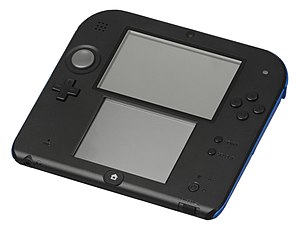Nintendo 2DS

A Black + Blue Nintendo 2DS.
|
|
| Developer | Nintendo |
|---|---|
| Product family | Nintendo 3DS family |
| Type | Handheld game console |
| Generation | Eighth generation |
| Release date | |
| Introductory price | US$129.99/AU$149.95 |
| Units shipped | Worldwide: 5.17 million (as of 30 June 2016[update]) |
| Media |
Physical and digital
|
| Operating system | Nintendo 3DS system software |
| CPU | Dual-Core ARM11 MPCore, single-core ARM9 |
| Memory | 128 MB FCRAM, 6 MB VRAM |
| Storage | Included 4 GB SD card 1 GB internal flash memory Cartridge save |
| Display |
Upper: 3.53" LCD @ 400×240 px (WQVGA) Lower: 3.02" resistive touchscreen LCD @ 320×240 (QVGA) |
| Graphics | DMP PICA200 GPU |
| Sound | Mono speaker, microphone |
| Camera | One user-facing and two forward-facing VGA cameras. |
| Connectivity | 2.4 GHz Wi-Fi, Infrared |
| Power |
1300 mAh lithium-ion battery
|
| Online services | |
| Dimensions |
Width: 14.4 cm (5.7 in) Height: 12.7 cm (5.0 in) Depth: 2.03 cm (0.80 in) |
| Weight | 260 grams (9.2 oz) |
| Backward compatibility |
Nintendo DS, Nintendo DSi |
| Predecessor |
Nintendo DS family Nintendo 3DS (XL) New Nintendo 2DS XL (concurrents) |
| Website | www |
The Nintendo 2DS is a handheld game console produced by Nintendo. Announced in August 2013, the device was released in North America, Europe and Australia on 12 October 2013.
The Nintendo 2DS is an entry-level version of the Nintendo 3DS which maintains otherwise identical hardware, similar functionality, and compatibility with software designed for the Nintendo DS and 3DS. However, the 2DS is differentiated by a new slate form factor rather than the clamshell design used by its precursors and by lacking the Nintendo 3DS's signature autostereoscopic 3D display. The 2DS is sold concurrently with existing 3DS models as an incentive to expand the market for Nintendo 3DS games; Nintendo of America president Reggie Fils-Aimé stated that the 2DS was primarily targeted towards younger players (such as those younger than age 7), whom Nintendo had previously advised not to use the 3D functionality on the 3DS due to potential eye health concerns.
Reception to the Nintendo 2DS was mixed; while Nintendo was praised for how it priced and positioned the 2DS alongside its higher-end counterparts, much of its criticism was directed towards its regressions in comparison to the 3DS, such as a design that some considered less appealing than that of the 3DS, its lower sound quality, and its battery life. However, the 2DS's design was praised by some critics for being more robust and comfortable to hold than the 3DS, especially for its target market. Some critics also felt that the lack of 3D support was an admission by Nintendo that the concept was a fad; however, Nintendo has since stated that autostereoscopic 3D would remain a part of their future plans.
Nintendo officially unveiled the 2DS on 28 August 2013 via a press release; members of the press were given a chance to demo the device in private prior to the announcement. According to Nintendo of America president Reggie Fils-Aimé, the Nintendo 2DS is primarily aimed at a younger demographic than the Nintendo 3DS — particularly, those younger than 7 years old; whom Nintendo had advised not to use the 3D features on the 3DS due to potential eye health concerns. The validity of Nintendo's claims were questioned by vision experts, however, who believed that the 3DS could actually help detect certain eye problems, and felt the warnings were for liability reasons rather than any realistic harm.
...
Wikipedia
